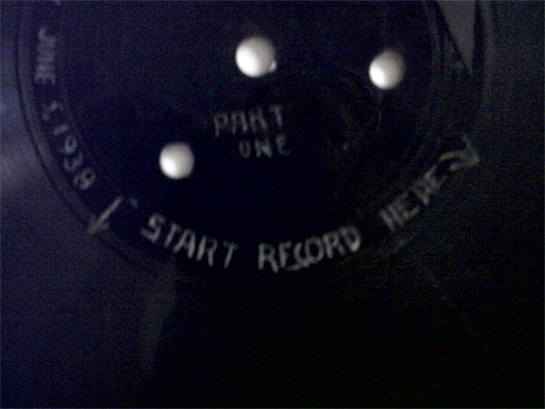Help a Technologizer Reader Digitize a 1938 Family Recording
By Harry McCracken | Wednesday, November 10, 2010 at 5:32 pm
I realize that I’m fairly well-informed about technology. But to borrow a line from a favorite former boss of mine, what I don’t know could fill a warehouse. Fortunately, the combined wisdom of the mighty Technologizer community can answer virtually any tech question. Including this one, I hope.
Technologizer reader Chuck Mayper has a phonograph (78rpm, I assume–or is it a 45?) from June 1938. It’s a recording of a family event. He’d like to digitize it, of course–a job than can normally be done with something like an Ion USB turntable. But both sides of this record have “Start Here” notations which seem to tell the listener to place the needle on the inside edge, not the outside one.


I don’t know much about old records, but here’s a strange coincidence: I just read a post at my friend Michael Barrier’s site about an acetate recording of part of the soundtrack of a Daffy Duck cartoon released in 1938. It, too, has a note about starting from the inside.
So does anyone know what the deal is–and, most important, how Chuck can create an MP3 or CD of this recording?
8 Comments
Read more:













November 10th, 2010 at 6:04 pm
I was thinking that an old record player in working condition isn't that hard to come by, and would not have automatic return for the tone arm, but then I realized: why can't you just play it outside-in, record it, and reverse it? If you can't find a turntable that will play 78s, you can also just speed it up.
Also, this: http://www.musicgrinder.com/how-to-play-acoustic-…
November 10th, 2010 at 7:03 pm
http://www.familymemoriesvideo.com/audio_transfer…
Bay Area service
November 10th, 2010 at 7:51 pm
This is an “inside start” disc. That was not uncommon back then, before “standards” settled down.
Evvywevvy’s idea won’t work. The spiral groove starts at the inside edge and finishes at the edge outside. No matter where you place the tonearm/stylus it will work it’s way outwards. The other thing you’d have to do is reverse the direction of the motor/platter for that to work.
It’d be a 78 or 33 (45’s came much later). There were 33 1/3 rpm “coarse groove” discs used in radio before the microgroove format was developed. Back in the sixties I occasionally came across them as radio transcriptions (for playing the old-time serials & dramas). We’d play them at 33 1/3 but use a “78” stylus.
Looks like this is an “acetate” disc (lacquer-coated aluminium platter), so handle carefully, as the surface can be fragile, and the coating can lift off the platter as it ages. If it’s in good condition now, I’d recommend transferring it soon, before it deteriorates.
As for advice –
1. See if you can find an enthusiast or professional to do the transfer for you. Properly playing the disc is a complex issue involving selecting the correct turntable speed, stylus size, geometry and tracking weight; and appropriate disc cleaning and preparation.
2. If that’s not possible, you’ll need to find a turntable without auto arm return, and a cartridge that can accept both 78 and microgroove conical and eliptical stylii.
3. Then you’ll need to establish which groove size it is – an expert should be able to “eyeball” it, but you might be able to decide by comparison with known coarse and micro grooves.
4. The disc should be carefully cleaned with a soft brush. Avoid liquids unless you’re sure that it won’t damage the disc.
5. Experiment with the cartridge wiring – it’ll be a mono recording, and left+right paralleled at the cartridge may give best results, or left-only, or right-only, or left&right reverse phase connected.
6. Once you get the audio into a computer, use click/hiss reduction software (standalone or a plugin for your favourite audio editor) to clean things up.
Phew! It’s a big subject, but I’d better stop there.
November 11th, 2010 at 3:39 am
This may be a long shot, but maybe one of the Lawrence Berkeley researchers mentioned in the following news article might have the time to assist? They developed a technique that uses light to optically read phonograph recordings:
http://news.cnet.com/2100-1027_3-5208224.html
November 11th, 2010 at 3:46 am
Here is the website of one of the LBL researchers with more recent information on their optical reconstruction technique for old records:
http://irene.lbl.gov/
I realize that finding an enthusiast with the right hardware is the most straightforward solution, assuming the disc is in playable condition, but I couldn't resist mentioning this neat approach!
Ben
November 11th, 2010 at 10:36 am
+1 for hiring an audio transfer service.
You don't want your first attempt at transferring audio from a type of record that you've never used before to be with a priceless family artifact.
November 11th, 2010 at 10:51 am
I agree with @psmerdon. An additional factor is whether the recording is vertical or lateral (referring to the undulations in the grooves that produce the sound–wiggles go side-to-side or up-and-down). That determines how properly to connect a stereo cartridge for playback (or just use one mono output). Sound will be crappy because modern discs are electronically equalized to RIAA standard; probably can RE-equalize this after capturing the sound. I use a Lexicon Lambda digitizer that I got from Guitar Center. Do not set recording volume too high or waveforms will be clipped and sound degraded.
November 11th, 2010 at 4:23 pm
I can transfer it for him. Feel free to contact me at joeblow7@earthlink.net, and see my page at http://joe.salerno.com/specaudio.html
I think all your questions were answers by previous posters.